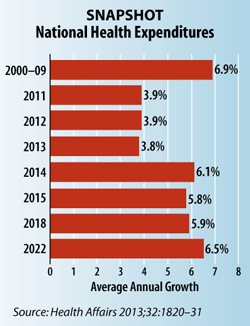ACA Expected to Help Revive Health Spending
As the Affordable Care Act (ACA) expands insurance coverage over the next decade, estimates predict that aggregate healthcare spending in the U.S. will approach growth rates that have not been observed since prior to the recession, increasing notably from the current annual growth rate of 3.8% to an average annual growth rate of 5.8%.
For 2013, healthcare spending growth is still projected to remain the same as in 2011 and 2012 due to the current sluggish economic recovery, continued increases in cost-sharing requirements for the privately insured, and slow growth for Medicare and Medicaid spending. This stagnation could start to lift as early as next year, though, according to the recent Health Affairs report, "National Health Expenditure Projections, 2012–22: Slow Growth Until Coverage Expands and Economy Improves."

The report predicts that 2014's growth in national health spending will jump to 6.1% as the ACA's major provisions go into effect. Notably, without these reforms projected growth would only rise to 4.5%. The use of medical services and goods—especially prescription drugs and physician and clinical services—among the newly insured is also expected to contribute to significant 12.2% and 7.7% spending increases in Medicaid and private health insurance, respectively.
Projections estimate that by 2022 the ACA will reduce the number of uninsured people by 30 million, which is one major factor predicted to maintain national health spending near 6% over the next several years. After the one-time effects of coverage expansion start to subside in 2016, an acceleration in economic recovery is expected to keep health spending growth buoyed. The report tempers this optimistic outlook, though, by noting that the increased growth will still be slower than the 6.9% growth rate experienced before the recession hit.